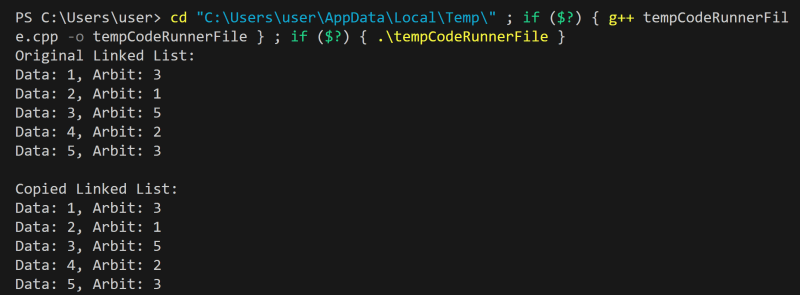Copy a linked list with next and arbit pointerIntroduction:Linked lists are fundamental data structures in computer science, offering dynamic memory allocation and efficient insertion and deletion operations. When dealing with a linked list that includes not only a 'next' pointer but also an 'arbit' (arbitrary) pointer, the task of copying becomes more intricate. This type of linked list is commonly known as a "linked list with next and arbit pointer." The "arbit" pointer points to any arbitrary node in the linked list, adding complexity to the copying process. Understanding the Linked List with Next and Arbit Pointer:A linked list with next and arbit pointer is a modification of the traditional singly linked list. Each node in this structure contains two pointers - 'next,' pointing to the next node in the sequence, and 'arbit,' pointing to any arbitrary node in the list, including itself or null. This 'arbit' pointer adds complexity to the copying process since a simple traversal may not suffice. The challenge in copying such a linked list lies in correctly replicating both the next and arbit pointers for each node in the new list. Simply copying the next pointers would result in a shallow copy, where the arbit pointers still point to the nodes in the original list. Naive Approach:A naive approach to copying a linked list with next and arbit pointers would involve iterating through each node, creating a new node, copying data, and updating the pointers accordingly. However, this approach encounters issues when dealing with arbit pointers, as the node to which they point might not have been created yet. Approaches to Copying a Linked List with Next and Arbit Pointer:Several approaches can be considered to copy a linked list with next and arbit pointers, but one of the most efficient methods involves a combination of iteration and hashing. 1. Iteration with Hashing: Step 1: Iteration for Next Pointers
Step 2: Iteration for Arbit Pointers
Step 3: Splitting the Lists
2. Recursive Approach: Another approach involves recursion, where each node is processed in a depth-first manner. While this method is elegant, it might suffer from stack overflow issues for large linked lists. Implementation:Explanation:
Program Output: 
Time and Space Complexity AnalysisTime Complexity: Node Duplication (O(n)): The first while loop iterates through each node in the original list and creates a copy node next to it. This operation is linear with respect to the number of nodes in the linked list (O(n)). Adjust Next Pointers (O(n)): The second while loop adjusts the next pointers of the original and copied nodes. It also sets the arbitrary pointers of the copied nodes. Similar to the first loop, this operation has a linear time complexity (O(n)). Separate Lists (O(n)): The third while loop separates the original and copied lists by adjusting the next pointers. Again, this is a linear time operation (O(n)). The overall time complexity is O(n), where n is the number of nodes in the linked list. Space Complexity:Node Duplication (O(n)): The additional space required for the copied linked list is proportional to the number of nodes in the original list, resulting in O(n) space complexity. No Extra Data Structures (O(1)): The algorithm uses a constant amount of extra space beyond the input. The space complexity is not dependent on the size of the input. The overall space complexity is O(n), where n is the number of nodes in the linked list. Conclusion:In conclusion, the task of copying a linked list with both next and arbit pointers presents a unique challenge that requires a thoughtful approach. This problem often arises in computer science interviews and is designed to test a candidate's understanding of linked list manipulation and algorithmic problem-solving skills. One common and efficient solution to this problem involves traversing the original linked list while creating a new node for each element encountered. During this traversal, the next pointers of the new nodes are linked to their corresponding elements in the original list. Subsequently, a second traversal is performed to establish the arbit pointers in the duplicated list based on the relationships between the original nodes. It's important to note that the time complexity of this solution is O(n), where n is the number of nodes in the linked list. This linear time complexity makes the algorithm quite efficient, as it avoids unnecessary duplications and ensures a streamlined process for copying both the next and arbit pointers. In summary, tackling the task of copying a linked list with next and arbit pointers requires a systematic and strategic approach. The solution described not only provides an effective means of achieving the duplication but also does so in a time-efficient manner, showcasing a balance between algorithmic elegance and practicality. |
 For Videos Join Our Youtube Channel: Join Now
For Videos Join Our Youtube Channel: Join Now
Feedback
- Send your Feedback to [email protected]
Help Others, Please Share










